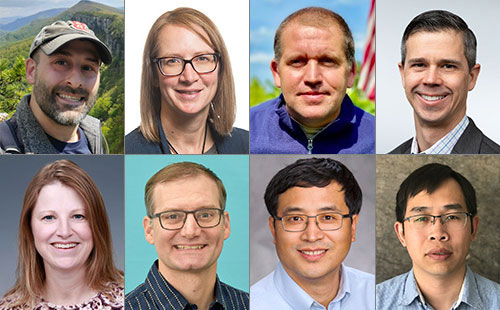ARM Modeling Outreach and Communication Plans Focus on E3SM

ARM’s new translator vision plan had eight authors: (top row, from left) Scott Giangrande, Jennifer Comstock, Scott Collis, John Shilling; (bottom row, from left) Krista Gaustad, Ken Kehoe, Shaocheng Xie, and Damao Zhang.
The DOE Office of Science Atmospheric Radiation Measurement (ARM) user facility is managed by the Office of Biological and Environmental Research. It provides the climate research community with strategically located in situ and remote-sensing observatories designed to improve the understanding and representation, in climate and earth system models, of clouds and aerosols as well as their interactions and coupling with the Earth’s surface.
As a result of the 2020 Triennial Review, the ARM User Facility was encouraged to develop a plan for engaging with the climate modeling community to understand how ARM data are used for model development and evaluation. Consequently, the ARM Science Translator team, a group of scientists who serve as liaisons between users and the ARM infrastructure, included outreach in their updated 3-year plan that was released in 2022. The Translator Plan lays out their development strategy, which includes value-added products (VAPs, higher-order derived data products), open-source software tools, and data visualization Jupyter notebooks.
New this year is a dedicated effort to reach out to modeling communities to understand ARM’s impact on models and identify areas where ARM can further collaborate and expand its resources for model development and evaluation. A natural starting point for this effort is the E3SM project. In April, ARM’s Associate Director for Research, Jennifer Comstock, and ARM’s Modeling Translator Shaocheng Xie, who also leads the lower-resolution E3SM Atmosphere Model (EAM) development, met with E3SM developers Peter Caldwell (lead of high-resolution, next generation EAMxx model – SCREAM) and Peter Bogenschutz, the developer of the E3SM Single-Column Model (SCM) and its doubling periodic cloud-resolving model (DP-SCREAM). During this engaging and productive meeting, several cloud regimes and ARM field campaigns of interest were identified as important for the SCREAM evaluation efforts. Instrument simulators and data uncertainty information are needed to improve model-ARM data comparison. Developing an ARM case library specifically for DP-SCREAM is highly desired. Looking to the future, ARM will continue to engage with the evaluation team to identify specific ARM datasets and time periods of interest to focus future development efforts.
Related Links
This article is a part of the E3SM “Floating Points” Newsletter, to read the full Newsletter check:


